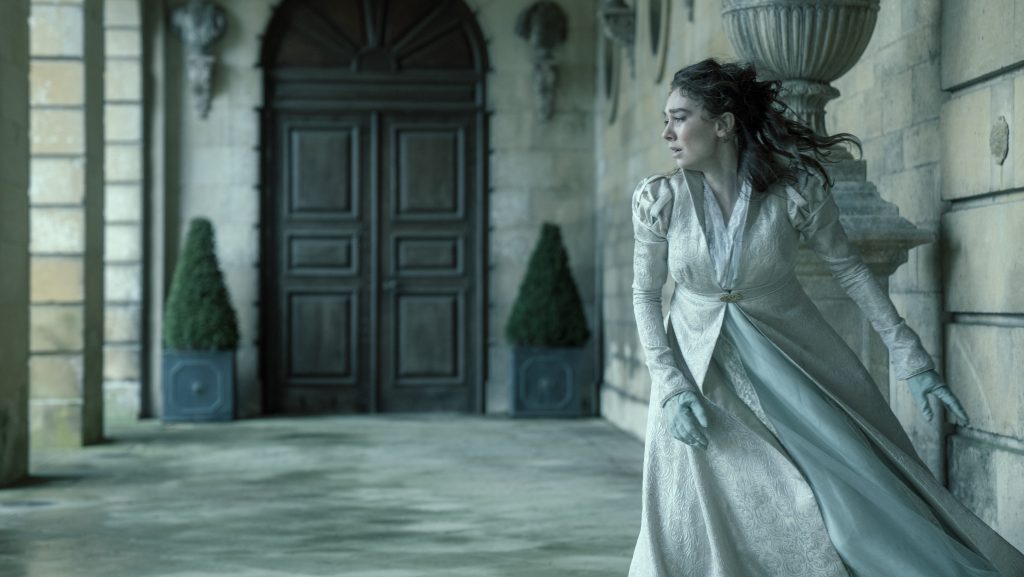
To put it mildly, Napoleon Bonaparte led a fascinating life, both on and off the battlefield. He was ruthless and cunning in planning strategic military campaigns, but was much more challenged when it came to his personal obsession and relationship with Josephine. Napoleon, directed by Ridley Scott, explores the French military leader in his quest for greatness on an epic scale, which required equal measure for the costume designs.
To achieve that, Scott reached out to his go-to costume designer, Janty Yates, an Academy Award winner for Gladiator, whose other Scott Free collaborations include American Gangster, Kingdom of Heaven, The Last Duel, and House of Gucci. While Yates was responsible for designing the looks of Josephine (Vanessa Kirby) and supporting artists, her colleague and compadre-in-arms David Crossman (Saving Private Ryan, War Horse, Lincoln) designed all things military for Napoleon (Joaquin Phoenix) and his soldiers.
Below The Line spoke with Janty Yates and David Crossman on each of their epic contributions to Napoleon. Ironically, much like in battle, they encountered many unexpected challenges that they had to conquer to make the costumes look as historically authentic as possible while under budgets and deadlines. It was finding all the right historical materials, including ones that were animal-free for the vegan practicing Phoenix. Over 4,000 costumes were designed, some of which didn’t make it into the final cut, which Yates jokingly hopes will be seen in the four and a half-hour version of the film.

Below The Line: Nice to meet both of you. Let’s begin with the historical references that you used for your work.
David Crossman: Luckily, Napoleon loved having his artists around him from the beginning of his career as a general. They were always with him, especially when they first went to Egypt, where he took a group of artists, scientists, and writers, when science and art were still kind of linked together as a thing. So all these parties would travel with Napoleon. You can find contemporary sketches that they’ve done at the time, which are very helpful to us because they have a real kind of energy to them, and then obviously you get the finished glossy portrait.
There’s obviously historical reference, but the art of it kind of moved. It influenced everything from the uniforms to the civilian clothing. This same artist was drawing costumes for the directory to wear or costumes to be worn at the coronation. So it was all kind of linked together in that way.
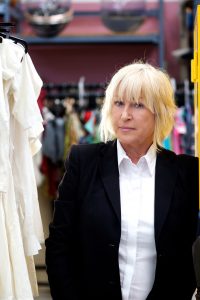
BTL: Janty, please tell me about your primary designs.
Janty Yates: Well, Joaquin was completely military, which David did, but we have history. We had a lovely catch-up on the first Zoom, because everything was COVID Zoom for his first fitting. But he’s David’s baby, except for the coronation and a suit, and that was about it, I think. But yes, the coronation was huge.
We completely copied Jacques-Louis David’s painting of the coronation, and the women all wore embroidered gowns, hand-embroidered by a woman in the home counties in gold bullion. The jewelry was made by our in-house jeweler, and the cloaks were embroidered in Pakistan in gold bullion. The wedding costume was his embroidered general’s uniform.
BTL: David, since your responsibility was military design, tell me how you worked with Joaquin.
Crossman: Joaquín just wanted to own the clothes as soon as possible. That’s what we were trying to do. We were trying to apply something to each scene, so he knew what he was doing. Then he’d look at each one and just work out what he could do with them or how he was going to feel about them. So we had a few fittings, but he was just desperate to get the stuff off us so he could just start wearing it to live in it a bit.
We were always telling him things like, “Napoleon often wore his hat constantly inside and all that kind of thing,” and we were trying to dissuade him from having everything undone all the time because Napoleon wouldn’t have done that. So he took that on board, really went for it, and was just constantly done up and rigid, which he kind of liked. I like the fact that he relentlessly wears the hat everywhere.
BTL: Well, speaking of the hat, we already know that it’s a vegan-friendly hat, but what about the rest of his clothes? Was it a conscious decision for you to look for materials as well that were animal-free.
Crossman: Yeah, because I couldn’t do anything with materials that he would object to. There were a lot of moleskins and cottons, and there was vegan leather for the boots and sword belts. And the nice thing is that vegan leathers have come on over the years. It used to be like an old cardboard box in a pair of vegan shoes, but they used to fall apart whenever they got wet. But now, with technology and processing, it’s all getting better. The choice of vegan leathers is much better these days. They make much more convincing boots.
BTL: How many different hats did you design for Napoleon?
Crossman: For him himself, he only wears about five or six. He went from a tricorn at the beginning. At first, when he’s in Paris, he’s got a simple bicorn and a civilian coat on, and he’s in the streets of Paris, sort of keeping a low-profile. It kind of moves on to his general and his first counsel, and then into the emperor. So there’s a fur hat in there for the retreat of Russia.
For the film, it was thousands of hats. We made all the bearskins, the shackles, the Tarleton hats, the bicorns, and so there’s just lots of different styles. It just ends up being this huge undertaking to make them.
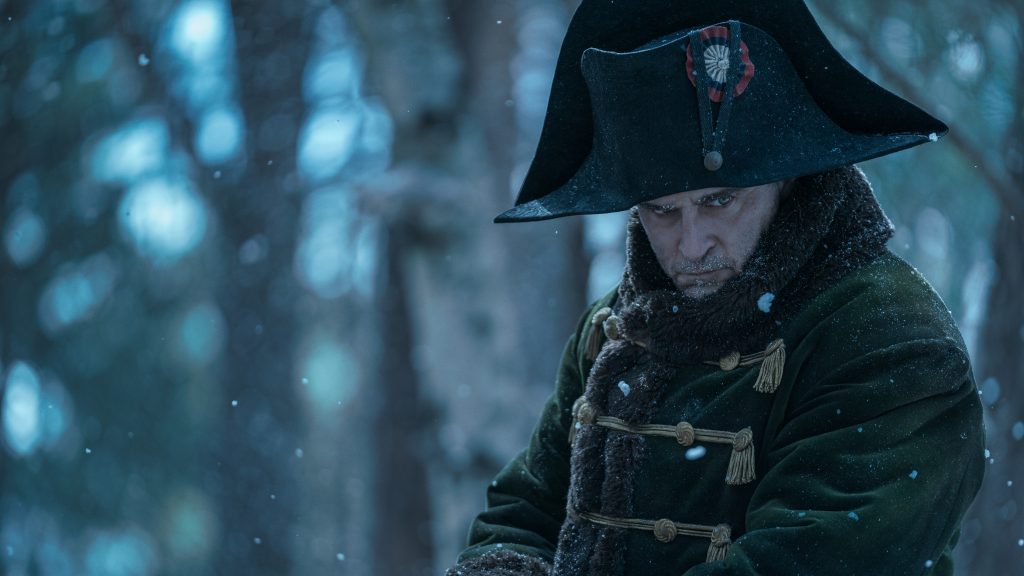
BTL: Was Joaquin the only one wearing the vegan materials or did you get that for everybody because of him?
Crossman: We definitely avoided using lots of animal products, like when we did the retreat from Russia. There was a moment—you don’t see it in this version of the film—but they’re putting on animal skins to keep warm; they’re killing horses and wrapping them around themselves, so we made these synthetic horse skins, and then we bought a cheaper version so we could do some of the crowd.
All of the fur that you see is fake; it’s all synthetic, so the guardsman’s bear skins, all that kind of thing, with or without Joaquin, I would have used synthetic furs where possible anyway. Even the sheepskins on the Cossack coats—this was a kind of new synthetic sheepskin from China that we made, and they made us a batch and sent it over. It was great because it was like skin.
BTL: Janty, let’s talk about dressing Vanessa. What was involved with some of her costumes?
Yates: Well, what was involved in the first place was that I’d made them for Jodie Comer (Killing Eve). She was Josephine. It was only two months before we shot, just before Christmas, that she pulled out because she had a commitment to a play, which she absolutely did wonders at. Ridley was kind of left high and dry, but he immediately found Vanessa. I mean, it was literally days.
Vanessa, although we had to do a lot of alterations, we didn’t have to make any new costumes. She loved, loved, loved what I’d made. which is always helpful. She is taller than Jodie but has the same size feet. It was just all actually dovetailed, thank God [laughs], because it could have just been a disaster waiting to happen.
BTL: So what was some of your favorite costumes to design for her?
Yates: I made 27 various coats as well that I loved because I’d bought all the fabric and the trim and we’d had them embroidered. We spent so much time just loving it and looking after it. They were entire creatures by the time they got to Vanessa. So I think she probably felt the love that we gave those dresses—all of them. And she wore them so beautifully. She was like a clothes horse. She’s so tall with this amazing long neck and, you know, beautiful hair. I was very blessed.
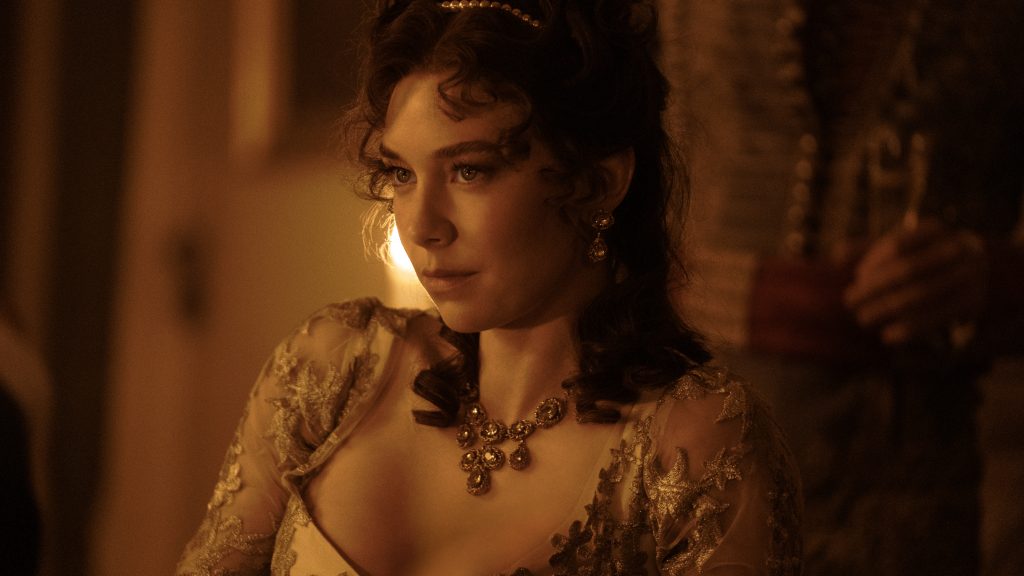
BTL: David, you designed all the military uniforms, which seemed daunting for such a huge cast in terms of all the soldiers involved. How’d you pull it off?
Yates: It was a very complex subject because it goes over from the 1790s to 1815, and loads of things change for all of the countries involved, from France to Russia to Britain to Austria. And so, you’re trying to cover all those periods, and you’re working within a budget, and you’re trying to get all this done, and you just don’t want it to look cheap and rented. We try to make shapes from originals, control the colors nicely, and just try to make them authentic-looking, trying to go through the beauty in the paintings. It’s getting the look of being authentic and real without jarring you when you’re watching.
BTL: Janty, what about the designs for the civilians in the film, like the peasants and the townspeople?
Yates: We also made a huge amount of civilian costumes— nowhere near the thousands—but there were all sorts of family members that didn’t make it to the film. There were something like 35 new characters that came in six weeks before we started shooting. For example, Napoleon’s mother had five outfits in the first five days of shooting, and they all had to be made, and his three sisters had five outfits all in the first five days, etc. They will be in the four and a half-hour cut, but it was quite a lot of work. We also made all of Barras, and we obviously made King Louis. He was glorious to me because he was just awash with embroidery.
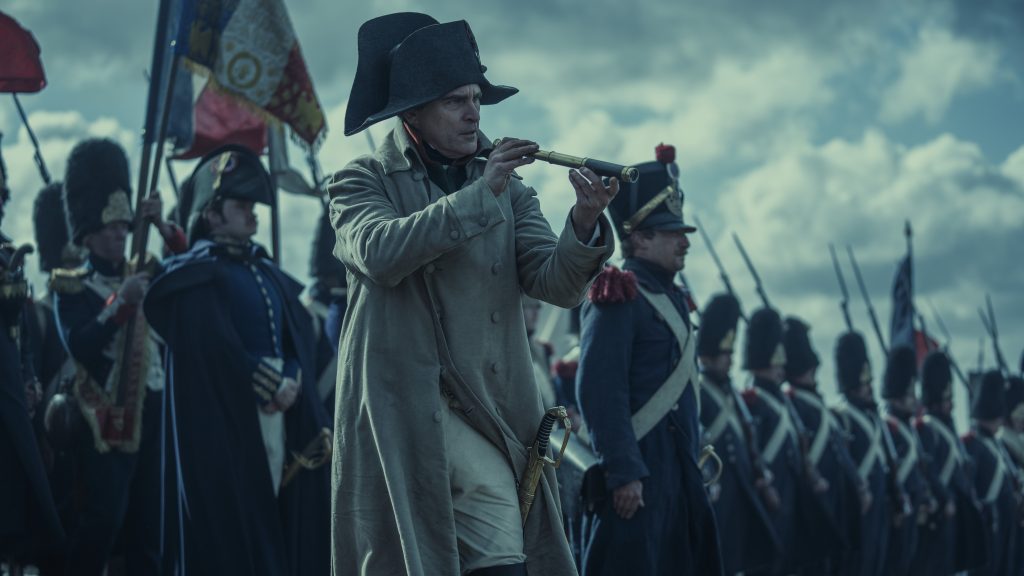
BTL: What were some of the biggest challenges?
Crossman: We just needed so much time, so you had to kind of guess what you might be doing, so you had to take the kind of gamble that, all right, we’re probably going to do this. The script’s changing all the time, so you’re trying to keep up with that. You’re trying not to blow all your money on the wrong thing. So you make these things and commit to them.
There’s so much embroidery to be done. The embroidery had to start months before we shot. We were trying to start that kind of work eight months before we were even on the job. We were doing samples of embroidery and then just looking at the kinds of costumes and how they could be used across the film. In the end, we reckon we made just under 4,000 costumes. That was the thing—just uniforms, plus, obviously, there’s the civilian end as well.
Yates: It was just amazing. David’s work is extraordinary because there’s not only the Russians, the Prussians, the Austrians, the French with their 40 different regiments, and the British, but he was making cossacks as well. He was making regiments within regiments for the Russians, the Austrians, and the Egyptians.
We were all a little bit thrown by the speed because the script was changing all the time. Logistics were a nightmare; we were up north, then we were down south, then we were in London, then we were back down south. And it was, especially for the military, absolutely horrendous. Now we’re just sitting, basking in the glory.
Crossman: It’s also trying to get Napoleon’s chasseurs, who look like hussars. You’re just trying to convey some of the complexity of Napoleon, who’s around Napoleon, his imperial guard, then it’s the army and spirals down like that.
BTL: Did you feel like you were scrambling to catch up?
Crossman: Where I felt most behind was the coronation, because we were so up against it with the schedule, and each day was a big event. So I think I’m just trying to catch up to get everything in for the coronation because the embroidered items are all arriving and literally coming off the plane out of a suitcase onto the body of somebody.
The whole UK schedule part of it was because the locations were kind of locked in, so they couldn’t really change or push anything, so it just made it very, very tight. One day, for instance, on Monday, we would be doing the Congress of Vienna with all the heads of state, and then we would be in Portsmouth at the end of the film, and then on Wednesday, the Battle of Waterloo was going to start. So you don’t have that time to go and think about the Battle of Waterloo. You’re relying on your team to get everything there and do it. It was that kind of relentless feeling all the way through.
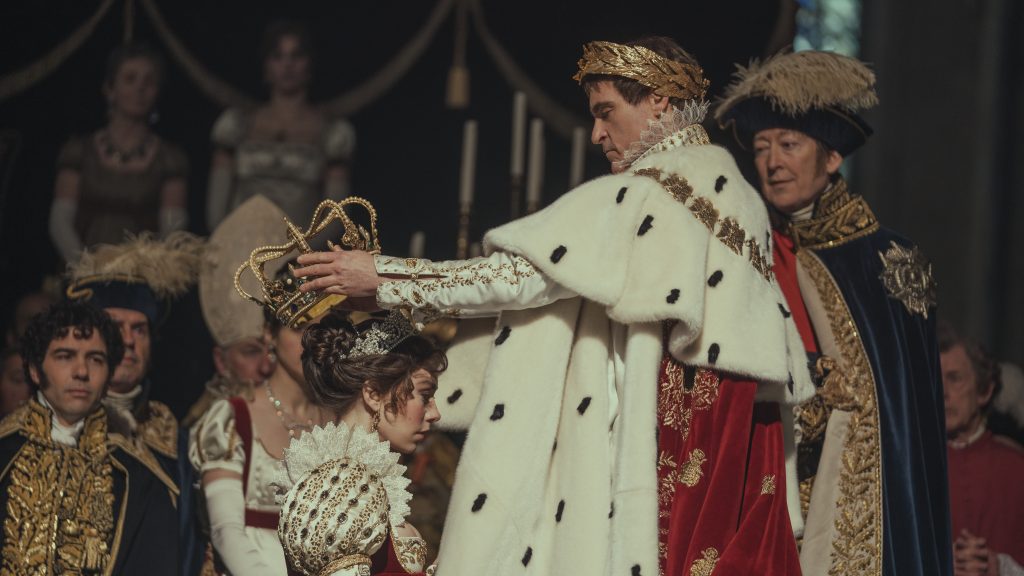
BTL: You obviously were like comrades-in-arms. Describe what works about your partnership.
Crossman: I think I met Janty when I was about 18 or something, so I’ve known her a long, long time. We’ve worked together lots of times. We’re friends, and we get along very well. It’s a lovely thing to work with Janty. I met Janty at a costume house called Bermondsey, and Janty was doing a Bryan Forbes TV thing called The Endless Game, and she came in and needed Russian uniforms. I was scared of her when I met her [laughs]. The thing is, we always got along, and I love Janty’s humor. When I’d left there, we started working together. I used to supervise occasionally for Janty, and then we did films together.
Yates: We did Charlotte Gray together and Enemy at the Gates. It’s a longstanding relationship; you know, we’ve known each other a long time. It’s a nice feeling, and we’re working together again now on Gladiator 2.
BTL: What’s it like working for Ridley Scott over the years?
Yates: I’m very, very grateful to work with Ridley, but you must never assume this is the last one. You can’t lose your edge, really, never. I’ve just been fortunate; he’s asked me back a couple of times. It’s traditional filmmaking.
Crossman: I love working with Ridley. I think we get along nicely. When he’s talking on the radio, he’s got a great sense of humor. When he’s sort of lining up shots and commenting on them, it’s great to listen to. He’s very visual. He’ll do a little sketch of what he wants, or he’ll talk about what he wants, and you definitely understand.
I think there’s a lot of excitement about working on his films. I think I’ve done about four; I’ve done some with Janty. I think he’s a good classic director to work for. He’s got good vision. You trust the vision, and his word is final, so you’re not having a dreary conversation with everyone’s opinion. You know, it’s down to Ridley.
BTL: So now when you watch the film, what are you most proud of?
Crossman: I think the coronation looks great. I think that looks really rich together. I love the music in it.
Yates: I’m so proud of it all. I’m so proud of David’s work. His work is sublime. I loved how Vanessa wore my clothes. She just did very well, but also all the other things that we did that hardly get a look in. I think they’ll probably get more screen time in the four and a half-hour version. I mean, God forbid anybody’s going to watch that, but at least they’ll get more screen time for everyone [laughs].
Napoleon is now playing in theaters.





